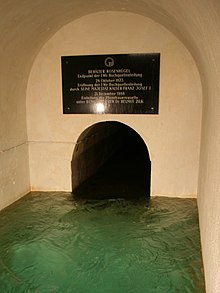Rosenhügel reservoir
The Rosenhügel water reservoir is the end of the first Viennese spring water pipeline and serves to supply the city of Vienna with water . From here the water of the 1st Viennese spring water pipeline is fed into the pipeline network of the city of Vienna. The property is managed by the Municipal Department 31 of the City of Vienna.
Geographical location
The water reservoir is located on the Rosenhügel on the edge of Hietzing and borders both Meidling and Liesing . The triangular property is bounded by the streets Atzgersdorfer Straße, Rosenhügelstraße and Schluckergasse.
Emergence
The Rosenhügel water reservoir was built with the 1st Viennese spring water pipeline under Mayor Andreas Zelinka and serves to supply the city of Vienna with drinking water . The groundbreaking for the construction took place on April 21, 1870. The reservoir was flooded for the first time on September 1, 1873 and officially opened with the 1st Viennese spring water pipeline on October 24, 1873 on the occasion of the world exhibition by Emperor Franz Joseph . The high location should facilitate the water distribution. Its main task is pressure regulation and the compensation of consumption peaks. When it was built, it was significantly undersized with a water reservoir of 2500 m³, although at that time it was the largest water reservoir that had ever been built up to then. Today the cistern holds 140,000 m³ of water, which corresponds to about a third of the daily water consumption in Vienna, and thus represents the largest drinking water container in Vienna. This was made possible by the construction of five additional chambers behind the historical facade, with chambers on the left and right ( 1st extension) of the first chamber and then two more, huge chambers (2nd and 3rd extension) were built behind these first 3 chambers. The first extension took place in 1878 under the mayor Julius Ritter von Newald .
Appearance
The storage facility is located underground. From the main entrance only the entrance to the historical first chamber and from the air and from the rear partially the entrances to the 3rd extension are visible. The main entrance is a magnificent building, as it was common in the imperial era: a stone wall that would be worthy of a castle wall and is interrupted by an equally powerful wooden gate. On the roof of this wall are the statues of St. Barbara and the spring nymph . There is a small fountain in the square in front of the entrance. The imperial appearance continues in the historical first chamber in the form of stylish cross vaults .
The surface of the area is laid out like a park, but not accessible to the public. The entire area is fenced and cordoned off.
The building is a historical monument.
Technical specifications
- Historical capacity: 2500 m³
- Current capacity: 144,000 m³
- Water temperature: 8-10 ° C
- Chambers: 6
Web links
Individual evidence
- ↑ Rosenhugel. Accessed December 26, 2018 .
- ↑ First mountain source line - Vienna History Wiki. Retrieved December 25, 2018 .
- ↑ Formation of the Vienna high spring water pipeline | Water. Retrieved December 25, 2018 .
- ↑ The gate to the moated castle. In: Vienna district newspaper "Liesing". bz Wiener Bezirkszeitung GmbH, January 16, 2019, p. 3 , accessed on January 17, 2019 (German).
- ↑ a b Geocaching: Geocaching - The Official Global GPS Cache Hunt Site. Accessed December 25, 2018 .
- ↑ City of Vienna, Paul Kortz: Rosenhügel water reservoir at the beginning of the 20th century. 1902, Retrieved December 26, 2018 .
- ↑ Category: Rose Hill Water Reservoir - Wikimedia Commons. Retrieved December 26, 2018 .
- ↑ a b Cool ten degrees in the Rosenhügel storage facility - oesterreich.ORF.at. Retrieved December 25, 2018 .
- ↑ Storage and cold chamber on Rosenhügel. Retrieved December 25, 2018 .
- ↑ A jewelry box for wet gold. Retrieved December 25, 2018 .
- ↑ StadtUNknown - Rosenhügel reservoir. Retrieved December 25, 2018 (German).
- ↑ List of monuments "immovable and archaeological monuments under monument protection" Vienna according to § 3 DMSG as of 2018. In: Bundesdenkmalamt Österreich. Federal Monuments Office Austria, January 18, 2018, accessed on December 25, 2018 (German).
Coordinates: 48 ° 9 ′ 42.2 ″ N , 16 ° 17 ′ 27 ″ E



